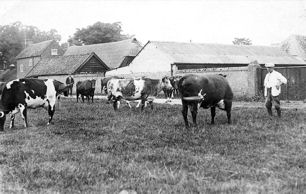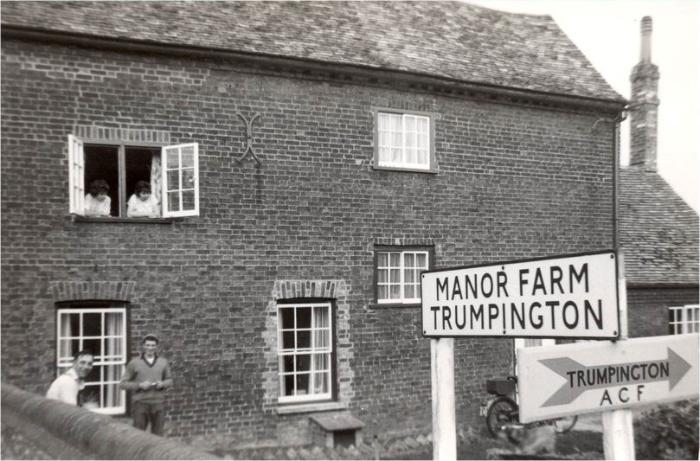Brian Goodliffe
This is the fifth part of a series of childhood memories of Trumpington in the 1940s and 1950s. For an introduction to the series, see Childhood Memories of Trumpington .

A herd of pedigree Jersey cows enthusiastically grazed the lush grass in Trumpington Park, but when they spotted me walking or playing there they would lift their heads and steadily wander over. They weren’t threatening, merely inquisitive and friendly. They loved having their necks and heads scratched, and would push against your moving hand in the same way as a pet dog or cat does when you stroke them, only rather more forcefully, and with great slicks of saliva flying around that you tried to dodge. I’d often jump up and grab a low branch that I could pull down so they could eat the elm leaves. They really loved this change of diet and would jostle for access to the smallish branches that I could lower. They’d attack the foliage like herbivorous piranhas, their slimy long wet tongues curling round the clusters of leaves and pulling them into their mouths. They were obviously bored with their normal diet of grass, grass, and more grass, and saw me as a friend who gave them a treat every now and again.

Early morning and again late afternoon, with traffic stopped, they would slowly stagger across the High Street, their hind legs knocking bulbous udders that would give Jordan an inferiority complex; and leaving a trail of something nasty for the held-up motorists to drive through as they resumed their journeys. And on into the dairy farm (Manor Farm), approximately where Gayton Close (Beverley Way) now is, for milking. There was a long bay of milking stalls on one side, and the cows seemed keen to get into the building and be relieved of their heavy loads. Above each milking station was a board with the cow’s name on, and other cryptic information about that particular beast. And yes: there was a Buttercup; and a Daisy. Although even by then the current occupants had become something like Buttercup III and Daisy IV, in a long family history that no doubt went from calf, to heifer, to milker, to meat pie. My favourite oversized-pet was called Diane. The intriguing thing is that without any guidance from the cowmen, the cows, without fail, always went to the same milking position every time. The Head Cowman tried to kid me that he’d taught them to read their own names, but I wasn’t that silly! But as each position was identical, just how did the cows get it right every time? I assumed that not only could they not read, but couldn’t count either, so they must have had some sort of instinctive sense of where to go, rather like a homing pigeon. Occasionally, swept along by the herd, they’d overshoot their allotted bay and cause bovine mayhem as they tried to turn around against the flow, and with their hooves clattering on the concrete floor, skedaddle back to their rightful bay, looking rather sheepish, if you’ll excuse the oxymoron.
Early every morning, my dad would bike up to the dairy to collect our daily three pints. This was proper milk, from a breed of cows renowned for its high cream output; and between cow and bottle it had merely been cooled. After a while in the bottle the cream would separate out and float to the top. If you were using it in tea or coffee you would first shake the bottle to mix it back in. But if you were having a real 1950’s treat, such as tinned peach slices, you’d carefully pour this layer of cream onto your dessert. Although occasionally I’m sure the milk had a slight aftertaste to it – a touch of elm perhaps – when I’d been too generous with my bovine treats.
Continue with the next part of Brian Goodliffe’s childhood memories of Trumpington in the 1940s and 1950s.